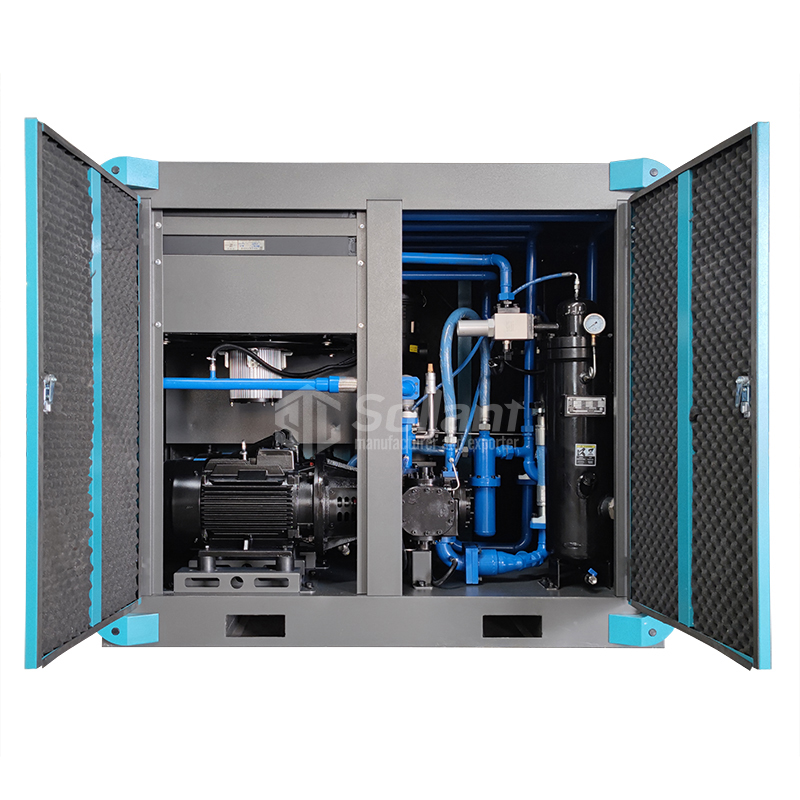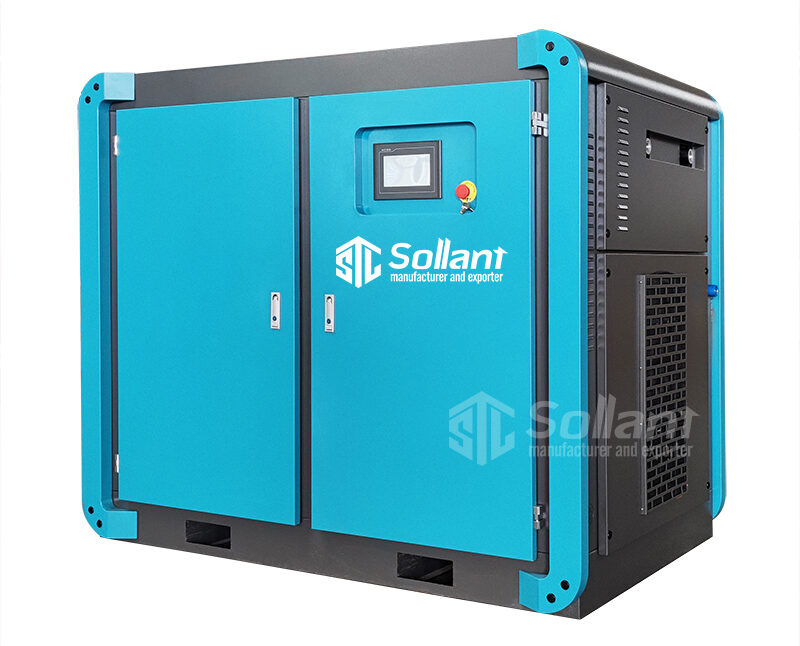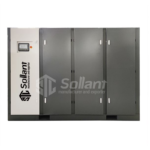In today’s industrial field, the screw air compressor has become the type of compressor with the largest number of reserves due to its durability and easy maintenance, and it has a wide range of uses. However, the energy utilization rate of the screw air compressor is still hovering at a low level.
Only about 20% of the electricity input to the screw air compressor is converted into effective compressed air power, and the rest is converted into heat. If the efficiency of the screw air compressor itself is improved to realize an energy-saving screw air compressor, huge benefits will be obtained.
Or you can choose a centrifugal air compressor through model selection and calculation, but this method requires a relatively large investment, and it is not recommended unless the user company has the intention.

Optimized gas delivery lines and tips for energy savings
Once the compressed air is generated, it needs to be transported to the place of use through the air storage tank and pipelines. During the transportation process, there are often problems in the pipelines.
These problems increase energy consumption and cause unnecessary waste. Through the energy-saving means of optimizing the pipeline and the end gas link, the air compressor system can be greatly energy-saving. This chapter explains common pipeline problems and briefly introduces solutions.
-
Insufficient capacity of the gas storage tank
In the application field, the problem that often occurs is that the capacity of the gas storage tank is insufficient. Due to the small capacity, the energy storage effect is poor, and the air pressure fluctuates greatly, resulting in repeated loading and unloading of the compressor, resulting in a large amount of energy waste.
By increasing the size of the air storage tank, the unloading power consumption of the air compressor will decrease if the single unloading time exceeds a certain period of time, resulting in an energy-saving effect.

-
Right angle elbow
The right-angle elbow at the connection of the pipeline has a great destructive effect on energy efficiency. The reasons are:
- The right-angle elbow forms a gas impact, and the local pressure increases, causing the compressor to continue to operate at a high pressure state, and it is easy to unload.
- The right-angle elbow increases the flow resistance and forms an additional work point.
For the right-angle elbow at the output port of the air compressor, the pressure of 0.5 bar can be consumed in severe cases. If a 6.5 bar pressure system is used on site, the energy loss of the right-angle elbow accounts for more than 7%, and the degree of damage can be seen. Reasonable optimization of pipeline connection points can significantly reduce energy loss, and this part of loss is almost eliminated.
-
The direction of the pipeline is not good
After the compressed air is sent from the unified air storage tank, it is transported to the gas consumption link through various pipelines. The efficient transmission forms include single-point daisy chain and multi-point ring. However, due to one-time investment savings and other reasons at the general user site, the direction of the air pipeline is often unreasonable, resulting in excessive pressure loss, resulting in the need to supply higher gas pressure.
For example, generally the air pressure at the end of the pneumatic site can work stably as long as it is greater than 4.5bar. However, due to the poor pipeline direction, the compressor must supply 6.5bar pressure. If the pipeline direction is optimized, it only needs to supply 5.8bar pressure, saving energy. The rate can reach about 10%.
-
Insufficient peripheral energy storage
In a production line, there are different types of gas consumption, such as:
a,Continuous air use links, such as air motors (hand-held grinders), etc., require continuous and reliable pressure;
b, small-scale pulsed air use links, such as pneumatic screwdrivers, pneumatic pistons, etc., require continuous and reliable pressure;
c, large-scale Large-scale pulsed gas consumption links, such as gas ash removal, injection equipment, etc., require large energy storage;
d, open gas consumption links, such as glass cooling, purging links, etc., require large flow rates and no clear requirements for pressure.
Since the above-mentioned various gas consumption links often coexist on the same section of pipeline, pulse gas equipment requires a large instantaneous gas supply, which will inevitably lower the pipeline air pressure, resulting in insufficient air pressure for continuous gas consumption links, which requires The air supply end supplies greater air pressure, which leads to a significant increase in energy consumption of the compressor.
Air pressure and air flow detection can be used to deploy gas storage tanks at accurate locations, increase local energy storage, improve local air pressure, reduce the overall air supply pressure, and achieve better energy-saving effects.
-
Adopt partial pressure air supply
In some areas, the supply needs of compressed air in the plant are divided into several types, as described in the previous chapters. For example, the instrument air supply terminal needs 4.5bar pressure, and the compressor is required to supply 6bar pressure, while the purge and cooling air only needs flow rate, and it will be fine as long as the pressure is higher than 2bar.
Then, if the whole plant supplies 6bar pressure uniformly, It will lead to a lot of waste. Beijing Times Technology has good experience in this field. Through the on-site inspection by experts, the partial pressure gas supply circuit is reasonably designed to achieve substantial energy saving. Some sites even save energy by more than 50%.
Gas parts replacement and leak detection
The compressor system is a continuous operation. During the long-term operation of various gas components and joints, there may be adverse phenomena such as performance degradation and air leakage. Test each gas use point of the enterprise to find out the links with low efficiency , and be replaced to achieve the greatest degree of energy saving.
Air compressor waste heat utilization and energy saving
The generation process of compressed air is relatively complicated. In the process of gas compression, the degree of heat generation is high, often reaching above 100 degrees Celsius. Only about 20% of the electric energy consumed by the air compressor is converted into compressed air power, and the remaining 80% is converted into heat. Therefore, the waste heat utilization value of the compressor is often higher.
-
Air compressor waste heat to make hot water
Use the hot oil and hot air during the operation of the air compressor to exchange heat, transfer the heat to the soft water medium, and then transfer the heat of the soft water medium to the hot water used by the user, two-stage heat exchange, Realize the utilization of waste heat.
This waste heat utilization method is mainly aimed at occasions with more compressors and more demand for hot water.
For example, various enterprises in the south have compressors that run for a long time, and the employees’ dormitories need hot water for bathing; coal mines have a large number of compressors that run, and the amount of hot water for workers’ baths is relatively large.
-
Air compressor waste heat refrigeration
Use the heat energy during the operation of the air compressor to generate high-temperature hot water, and then use the high-temperature hot water as a heat source to drive the lithium bromide unit for refrigeration, which can generate chilled water to supply the production process.
For example, pharmaceutical companies use the waste heat of centrifugal air compressors to generate hot water at 90 degrees Celsius to drive lithium bromide units for refrigeration, to make up for the shortage of chilled water, and to greatly reduce the utilization rate of refrigeration compressors, with remarkable energy-saving effects. Electronics companies use the waste heat of compressors to generate hot water at 95 degrees Celsius to drive lithium bromide refrigeration, and the resulting chilled water supplies air conditioners and production lines in production workshops.
Air compressor attached dryer energy saving
In the chemical industry and other occasions, the moisture content of the compressed air is required to be high, so the use of a cold dryer or a suction dryer to dry the compressed air will also bring additional energy consumption.
-
Cold dryer linkage
In some sites, the cold dryer runs all year round, and the operation mode is relatively extensive. Evaluate the humidity (dew point) of the compressed air and link the air dryer to achieve a better power saving effect.
-
Optimization of suction dryer
The general adsorption dryer has two kinds of energy consumption:
- Loss of compressed air;
- Electricity loss for regenerative heating;
In some sites, the loss of the drying machine is relatively large, and the optimized drying machine can greatly reduce the gas consumption and power consumption, eliminate unnecessary losses, and realize energy saving.
-
Smart steam trap
In many sites, in order to achieve drainage, the steam traps have not been carefully controlled. If they are opened for a long time, there will be continuous leakage. The efficiency itself is not high, and the compressed air is more precious, so the power consumption caused is quite amazing.
Through intelligent steam trap control, the opening time of the steam trap is greatly shortened (by 90%), and continuous leakage is eliminated. The payback period of this technology is very short.
Sollant Focus on Energy Saving.



